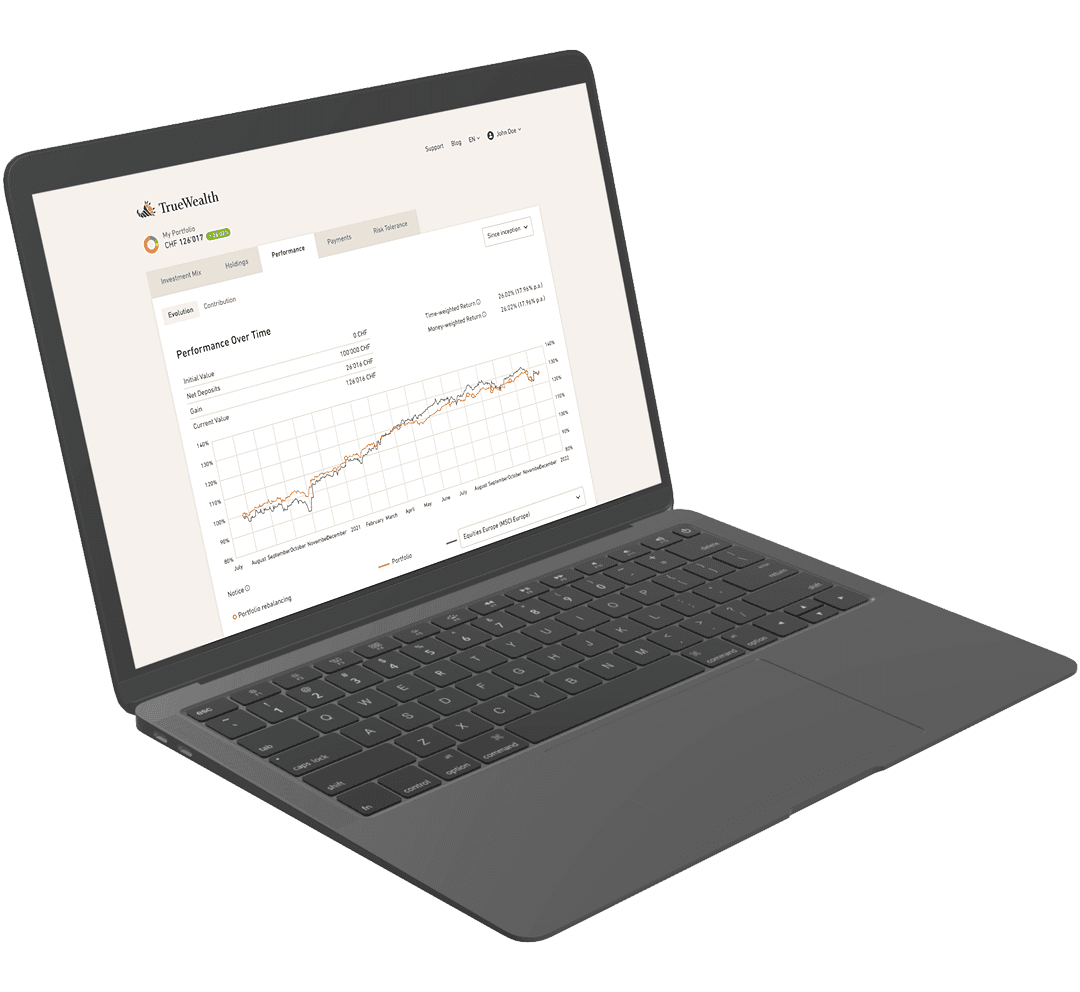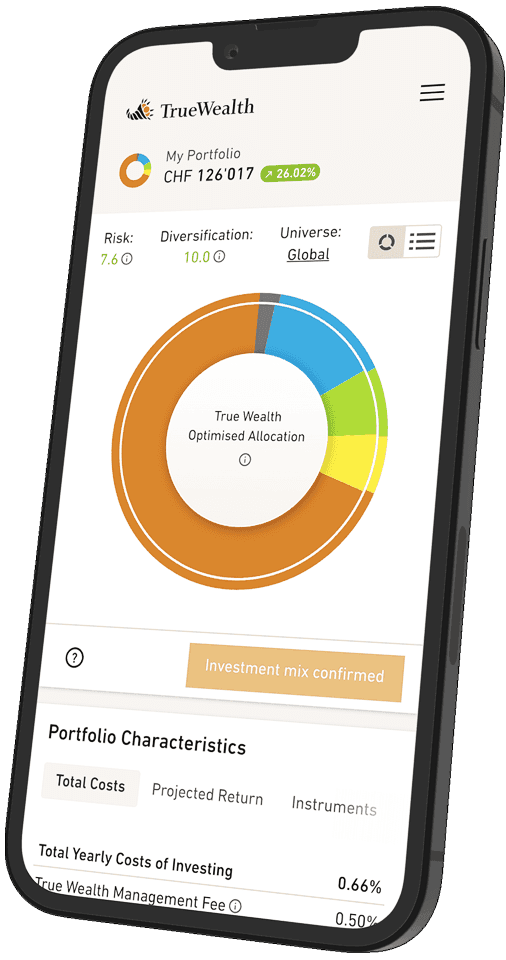
«Passively invested: We are active so that you can stay relaxed»
Behind the scenes: How the robo-advisor trades for you
Passive investing – it sounds like doing nothing. But in fact, trades are needed every day to keep portfolios on track.
At True Wealth, we focus on passive investing. We do not try to beat the market. But we do offer a relaxed way to participate in the returns of the market – transparently and much more cheaply than you are used to from asset management.
However, passive investing is not quite as passive as the name sounds. On the contrary: day after day, trades are necessary to keep our clients' strategies on course or to bring them back on course. Here you can discover what we do for you. How it works exactly. And what it means for you.
Let's start with the reasons why trades are necessary:
- Rebalancing
- Change of strategy
- Cash inflow or outflow
Rebalancing
Diversification is important for a good portfolio, this cannot be emphasized often enough. (Want to know exactly why? We explained it in detail in the article “Put all your eggs in one basket: diversification”).
You can see how diversified your portfolio is by looking at the different sized pieces of the pie chart. However, the stocks you chose last week may have already gone off the rails this week – depending on what has happened on the markets in the meantime.
If the equities in your portfolio have performed better than the other asset classes, then the proportion of equities is now higher. It's time to sell equities counter-cyclically – and buy other asset classes to the same extent, for example bonds. Assuming that both asset classes each had a 40 percent share at the beginning, then not only has the share of equities risen – but the share of bonds has also fallen.
Our algorithm therefore keeps all customer portfolios under constant observation. If your portfolio deviates from the target value by more than around two percent, rebalancing begins automatically – and your positions are brought back to the target values.
Depending on the scientific study, staying exactly on target will bring you around half a percent additional return per year. (Here you will find the link to the article “Rebalancing: Half a percent extra”).
Change of strategy
Most people do best in the long term if they stick to their investment strategy. That's why we always recommend this to our clients. (For example, in the article “Invest regularly – Even after losses”)
However, you can also change the strategy for your portfolio at any time if you wish. More equities and fewer bonds. More commodities in particular, but less of all other asset classes. Or vice versa. As soon as you give us a new strategy, we will bring your portfolio back on track in detail.
When you turn the knobs in your asset allocation, you set new target values for your portfolio. Our algorithm recognizes a deviation from the new values at the next review. It then automatically generates the appropriate trades for all ETFs that therefore need to be bought or sold.
Cash inflow or outflow
If you pay more money into your True Wealth account, the asset allocation is momentarily thrown out of kilter. Because suddenly your portfolio contains exactly this amount of uninvested money. In the short term, the cash share has risen, while the shares of all other asset classes have fallen.
But the next time you check, our algorithm recognizes the difference. It then automatically generates the trades so that we automatically buy exactly the right amount of all securities for your account. And if you want to withdraw money, our system generates the appropriate sell orders.
Different occasions, one process
Whatever the reason for the trades: The same thing always happens behind the scenes. Our algorithm called “Rebalancer” lives up to its name. It rebalances the portfolio and generates exactly those trades that achieve the target values.
A maximum of two percent, for a maximum of two days
We usually run the “Rebalancer” every two (stock market) days. It acts when a deviation of around two percent is exceeded. Rebalancing therefore takes place regularly – and not just once a quarter, as is the case elsewhere, where rebalancing is often still carried out manually. Deviations in your portfolio therefore last a maximum of two days. As a rule, they do not exceed two percent. How exactly do we do this?
Two steps to portfolio rebalancing
Two steps are required to rebalance your portfolio. Each of these steps currently takes one trading day.
Step 1: The ETF trades in rebalancing. Here we trade the actual securities in the investment universe, the ETFs on equities, bonds, real estate and commodities. If the custodian bank reports success, step 2 follows the next day.
Step 2: Forex trades for currency balancing. We do not trade currencies for their own sake. Sometimes, however, the trades from step 1 make a reallocation necessary. For example, if we sold American equities and bought Swiss bonds in step 1, we swap the surplus dollars for Swiss francs in step 2.
On the third day, the custodian bank reports the success of the currency trades. The process is complete – and can start all over again with step 1.
While your portfolio is now balanced, for other clients it is just beginning. And if you have changed your strategy, deposited new money or the markets have fluctuated greatly, then it starts all over again for you too.
Rebalancing two to three times a week
We trade for you every trading day, alternating between ETFs and currencies. This results in two or three appointments per week for step 1, the actual rebalancing. And three or two dates for step 2, the currency rebalancing.
A typical week therefore looks like this: rebalancing on Mondays, forex on Tuesdays, rebalancing on Wednesdays, forex on Thursdays, rebalancing on Fridays. The next week then starts on Monday with Forex. We initiate all trades in the afternoon – unless the stock exchanges are closed for a public holiday.
A maximum of four days until payout
We hope we make you happy and that you continue to entrust us with the management of your assets. But some clients change their minds. And sometimes even the most satisfied customers need money immediately.
That's why you can withdraw your assets – in whole or in part – at any time. However, we require the two days for the two trading steps. In the worst-case scenario, it can take up to 48 hours until the first step – if you place your order after rebalancing. However, the account-holding bank can transfer your money to you on day four at the latest.
In blocks, but no block trades
If rebalancing is necessary, our system triggers all orders for all client accounts at the same time. The software processes all trades simultaneously, which saves time and costs – so we can keep the fees low for you.
So we trade in blocks. But in each individual customer account separately, exactly as many shares of the ETF as are required for precisely this account.
These are therefore not block trades in the traditional sense. We do not match our clients' trades with each other. From the outset, all trades are only booked to the client accounts by the account-holding bank.
Fees are charged by the account-holding bank for each of these trades. Thanks to the volume advantage resulting from the block trades, the trading fees are very low and are therefore included in our asset management fee (i.e., we reduce our management fee by the accrued trading fees and show this clearly in the fee statement).
Unlike other asset managers, True Wealth never trades securities in its own name, only to transfer them to client accounts at a later date. What belongs to you is never outside your custody account.
Relaxed out of conviction
For True Wealth, trading is not an end in itself. It is always a means to an end: we want to keep our clients' investment strategies on track with rebalancing or quickly implement a new strategy that they choose themselves.
We set limits for our stock market orders so that the market cannot surprise us with major fluctuations. But we don't sit in front of flashing terminals and chase prices. Nor do we try to improve the price just a tiny bit by making aggressive bets.
Because we don't want to beat the market. We want you to be part of it and benefit from the growth. We are active so that you can remain passive. Completely relaxed.
Links
About the author

Founder and CEO of True Wealth. After graduating from the Swiss Federal Institute of Technology (ETH) as a physicist, Felix first spent several years in Swiss industry and then four years with a major reinsurance company in portfolio management and risk modeling.

Ready to invest?
Open accountNot sure how to start? Open a test account and upgrade to a full account later.
Open test account